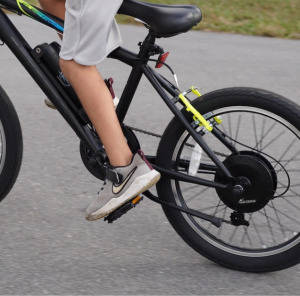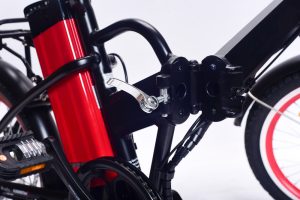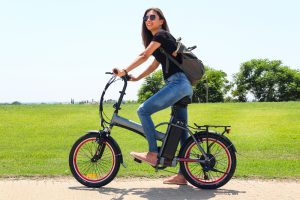E-bikes, or electric bicycles, have revolutionized the way we approach cycling. They offer a combination of manual pedaling and electric assistance, making long-distance travel more accessible and enjoyable. In this guide, we will explore whether you can travel 100km in a day on an e-bike, providing detailed insights into preparation, route planning, e-bike maintenance, and more.
Understanding E-Bikes

What is an E-Bike?
An e-bike is a bicycle equipped with an electric motor that provides assistance while you pedal. This motor can significantly reduce the effort required to ride, especially on hills or over long distances. E-bikes come in various styles, including commuter, mountain, and road bikes, each designed for different types of riding experiences.
Types of E-Bikes
Commuter E-Bikes
These e-bikes are designed for daily transportation, featuring comfortable seating, robust frames, and integrated lights and fenders for safety and convenience.
Mountain E-Bikes
Mountain e-bikes are built for off-road adventures, with features like suspension systems, durable tires, and powerful motors to handle rugged terrain.
Road E-Bikes
Road e-bikes are optimized for speed and distance on paved surfaces, often lighter in weight and with narrower tires for reduced rolling resistance.
Planning Your 100km E-Bike Journey

Assessing Your Fitness Level
Before embarking on a 100km journey, it’s important to assess your fitness level. E-bikes provide significant assistance, but endurance and stamina are still required for such a distance. If you are new to cycling or e-biking, consider starting with shorter rides to build up your endurance.
Choosing the Right E-Bike
Selecting the right e-bike is crucial for a successful 100km trip. Factors to consider include:
- Battery Capacity: Higher capacity batteries (measured in watt-hours, or Wh) will last longer, essential for long distances.
- Motor Power: More powerful motors (measured in watts) provide better assistance, especially on hilly terrain.
- Comfort Features: A comfortable saddle, ergonomic handlebars, and a good suspension system can make a long ride more pleasant.
Mapping Your Route
Planning your route is another critical step. Use cycling apps or maps to find e-bike-friendly paths, and consider the following:
- Terrain: Opt for routes with minimal elevation changes if possible.
- Rest Stops: Identify potential rest stops along the way to recharge both your body and your e-bike if necessary.
- Scenic Routes: Enjoy the journey by choosing scenic routes that offer pleasant views and a refreshing riding experience.
Preparing for the Ride

E-Bike Maintenance Check
Before setting off, conduct a thorough maintenance check on your e-bike:
- Battery: Ensure it is fully charged and functioning properly.
- Tires: Check for proper inflation and any signs of wear or damage.
- Brakes: Verify that they are responsive and in good condition.
- Chain and Gears: Lubricate the chain and make sure the gears are shifting smoothly.
Packing Essentials
Pack the following essentials for a 100km ride:
- Spare Battery or Charger: Depending on the range of your e-bike, you may need to recharge during your trip.
- Repair Kit: Include tools for minor repairs, such as a multi-tool, tire levers, and a patch kit.
- Hydration and Snacks: Bring enough water and energy-boosting snacks to keep you fueled throughout the ride.
- Weather-Appropriate Clothing: Dress in layers and bring rain gear if necessary.
Maximizing Battery Life

Efficient Riding Techniques
To make the most of your e-bike’s battery life, consider the following riding techniques:
- Pedal Assist Levels: Use lower assist levels on flat terrain and reserve higher levels for hills.
- Steady Pace: Maintain a steady pace to avoid unnecessary acceleration and deceleration, which can drain the battery faster.
- Pedal Consistently: Keep pedaling to reduce the load on the motor and extend battery life.
Battery Management Tips
- Avoid Full Drains: Try not to let the battery drain completely, as this can reduce its lifespan.
- Proper Charging: Follow the manufacturer’s guidelines for charging to ensure optimal battery health.
- Temperature Awareness: Extreme temperatures can affect battery performance, so avoid exposing your e-bike to very hot or cold conditions.
Safety Considerations

Wearing the Right Gear
Safety should always be a priority. Wear a properly fitted helmet, reflective clothing, and gloves. Additionally, equip your e-bike with front and rear lights, especially if you plan to ride during early morning or late evening hours.
Following Traffic Rules
Adhere to local traffic laws and regulations. Use bike lanes where available, signal your turns, and stay aware of your surroundings to avoid accidents.
Staying Visible
Enhance your visibility by wearing bright or reflective clothing and using lights and reflectors on your e-bike. This is particularly important when riding in low-light conditions or busy areas.
Managing Fatigue and Comfort

Taking Regular Breaks
Plan to take regular breaks to rest, hydrate, and refuel. Stretching during breaks can help prevent muscle stiffness and fatigue.
Adjusting Your Riding Position
Ensure your bike is properly adjusted to fit your body. A well-fitted bike can prevent discomfort and injury. Adjust the saddle height, handlebar position, and consider using padded shorts or a gel seat cover for added comfort.
Environmental and Weather Factors

Checking the Weather Forecast
Monitor the weather forecast before and during your ride. Be prepared for changes in weather conditions, and have appropriate gear for rain, wind, or sun protection.
Navigating Different Terrains
Be prepared for various terrains and surfaces. Gravel, sand, or uneven roads may require different riding techniques and can impact your speed and battery usage.
Health Benefits of Long-Distance E-Biking

Physical Fitness
Long-distance e-biking can improve cardiovascular health, build muscle strength, and enhance endurance. The combination of manual pedaling and electric assistance provides a balanced workout.
Mental Well-Being
Cycling outdoors has been shown to reduce stress, anxiety, and depression. The sense of achievement from completing a long-distance ride can also boost your mood and confidence.
Eco-Friendly Travel

Reducing Carbon Footprint
E-biking is an environmentally friendly mode of transportation. By choosing an e-bike over a car, you can significantly reduce your carbon footprint and contribute to a cleaner environment.
Promoting Sustainable Transportation
E-bikes offer a sustainable alternative to traditional vehicles, promoting healthier lifestyles and reducing traffic congestion and air pollution in urban areas.
FAQs
1. How long does it take to travel 100km on an e-bike?
The time it takes to travel 100km on an e-bike varies based on factors such as the rider’s speed, terrain, and level of pedal assistance. On average, it can take anywhere from 4 to 6 hours.
2. Can I ride an e-bike in the rain?
Yes, most e-bikes are designed to be water-resistant. However, it’s important to check the manufacturer’s specifications and take precautions such as wearing waterproof gear and ensuring your e-bike’s electrical components are protected.
3. How often should I service my e-bike?
Regular maintenance is crucial for keeping your e-bike in good condition. It’s recommended to service your e-bike every 500-1000km, or more frequently if you ride in harsh conditions.
4. What should I do if my e-bike battery runs out mid-ride?
If your e-bike battery runs out, you can continue pedaling manually to reach your destination or a charging point. Consider carrying a spare battery or identifying charging stations along your route.
5. Are there any legal restrictions for riding an e-bike?
E-bike regulations vary by region. It’s important to check local laws regarding speed limits, helmet requirements, and where e-bikes are allowed to be ridden (e.g., bike lanes, roads, or trails).
Conclusion

Traveling 100km in a day on an e-bike is not only possible but also an enjoyable and rewarding experience. With the right preparation, route planning, and understanding of your e-bike’s capabilities, you can embark on long-distance journeys with confidence. E-bikes provide an excellent way to explore the outdoors, improve your fitness, and contribute to a more sustainable future. Happy riding!
